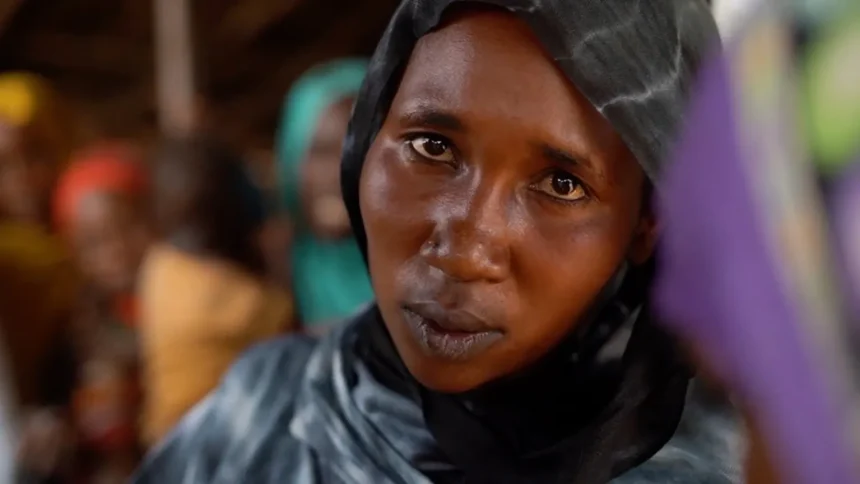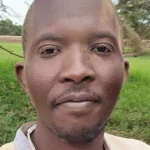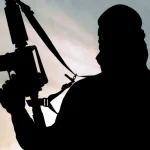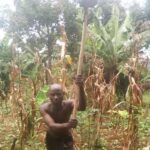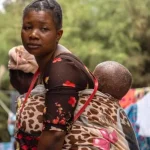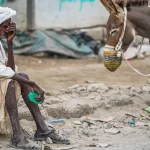The woman with sad eyes and a quiet voice is just one of the millions of people living in camps for those forced to flee their homes in Sudan, where a civil war broke out a year ago between the army and an armed paramilitary group. The country now faces what the UN says is the “world worst hunger crisis”.
Qisma Abdirahman Ali Abubaker goes through the motions of waiting in line to pick up her food ration, but her heart is not in it.
The small bag does not have to stretch as far as it used to for her family.
Three of her children have died of disease and malnutrition in the past four months, she says. The oldest was three, another was two years old, the last was a six-month-old baby.
Ms Abubaker has taken refuge at Zamzam Camp for displaced people in Northern Darfur, part of a region in the west of the country, amid warnings of a catastrophic nutrition crisis there.
It is the oldest and largest such camp in the country, but there is fresh desperation and grief as Sudan’s war grinds into its second year.
The medical charity Médecins Sans Frontières (MSF) says it found in January that at least one child in the camp dies every two hours. With little food, clean water or healthcare, illnesses that could once be treated now kill.
MSF is one of the last international humanitarian agencies still on the ground in Darfur.
It has just completed a mass screening of vulnerable women and children in Zamzam and shared the results exclusively with the BBC.
The agency found that three out of every 10 children under five were acutely malnourished, as well as a third of pregnant and breastfeeding mothers, confirming fears of a “catastrophe” that an earlier survey had suggested.
This is double the threshold for a nutrition emergency, and probably just the tip of the iceberg of Sudan’s hunger crisis, says Abdalla Hussein, MSF operations manager for Sudan.
“We have not reached all the children in Darfur, not even in North Darfur, we’re talking about only one camp,” he told me at the MSF regional headquarters in Kenya’s capital, Nairobi.

Access to Darfur is extremely difficult for foreign journalists as well as aid agencies, but we worked with a local cameraman, and Ms Abubaker told him her story.
She could not afford to take her children to hospital or buy medicine.
“My first child died on the way home from the pharmacy, and the second child died after six days due to malnutrition,” she says.
The baby fell sick and died three days later.
Ms Abubaker’s family are smallholder farmers like many in Darfur. They have struggled to grow enough food, and the violence and insecurity of the war has severely disrupted farming.
“People are sick and hungry,” she tells the BBC. “The displaced people are jobless and the only people who have money are [government] employees. Ninety per cent of the people are sick.”
Zamzam was already fragile, formed by those caught up in ethnic violence 20 years ago, and almost entirely dependent on humanitarian aid.
But the food supplies stopped with the war. Most aid agencies evacuated as the paramilitary Rapid Support Forces (RSF) took over large swathes of the region.
Fighters for the RSF and its allied militias are accused of looting hospitals and stores, something which the RSF has consistently denied.
Getting new supplies transferred across conflict lines has proved almost impossible. Aid workers say the Sudanese military authorities are too slow to issue visas and internal travel permits.
And the army has blocked land routes from neighbouring Chad, saying it needs to stop weapons shipments to the RSF.
That barrier has eased slightly for food supplies – the World Food Programme recently managed to bring in two convoys – but not nearly enough.
The lack of food combines with a breakdown in health services.
Across the country only 20-30% of health facilities are still functional.

One of those is the Babiker Nahar Paediatric hospital in the city of Fasher, near Zamzam Camp, which has a therapeutic feeding centre for children and intensive care treatment for the worst cases.
Both wards were full on the day our cameraman visited.
Babies with tubes in their noses whimpered quietly in their mothers’ arms.
Amin Ahmed Ali fed her tiny son serum through a syringe – she has six-month-old twins slowly recovering from weeks of dysentery. Other children ate from packets of calorie-rich food.
Dr Ezzedine Ibrahim says that the hospital was dealing with cases of malnutrition before the war, but now “the numbers have doubled”.
“Every month and the next month the numbers increase, despite the fact that we in Northern Darfur we had a system, a full nutritional programme which continued but it lapsed because of the war.”
This is about as good as it gets for child healthcare in Darfur, other places are even more cut off and desperate.
A regional emergency worker sent us images from areas in the region that aid workers have called a “black hole” in humanitarian assistance.
There is a photo of a three-year-old emaciated little girl from Kalma IDP Camp in Southern Darfur, named as Ihsan Adam Abdullah. She is said to have died last month.
Another photo shows an equally wasted little boy, from Genubia Camp in Central Darfur. His mother, Fatima Mohamed Othman, recorded a video pleading for help to feed her 10 children – anything, she says, even “something small – they are living between starvation and death”.
MSF is about to open a 50-bed tent hospital in Zamzam and is appealing for other international aid agencies to return to share the heavy humanitarian load.
“We need a massive mobilisation of humanitarian aid to reach the population that is cut off,” says Mr Hussein, as well as access with “permits and visas to be simplified and the borders to be opened”, and respect for humanitarian personnel and civilian infrastructure.
Without these basic conditions it will not be possible to turn the tide on this colossal crisis, and many many more children will die.

